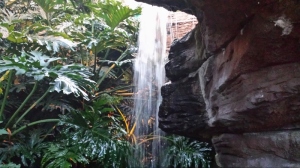 I’d never really been interested in the Civil War… not really. American history in general was never really my cup of tea. But researching my family has brought those parts of history alive for me as I began to understand how events affected my ancestors directly. So, when I realized my route lead me right by it, I added a stop in Gettysburg to my road trip.
I’d never really been interested in the Civil War… not really. American history in general was never really my cup of tea. But researching my family has brought those parts of history alive for me as I began to understand how events affected my ancestors directly. So, when I realized my route lead me right by it, I added a stop in Gettysburg to my road trip.
I’m told the way to go is to hire a tour guide at the Museum and Visitor’s Center and have him or her hop in your car with you. As a solo traveler that wasn’t going to happen. Instead, I made sure I had a book, in this case Mark Grimsley’s Gettysburg: A Battlefield Guide (older but useful), and due to weather considerations (overcast with periodic downpours) I made a very short list of sites or monuments I wanted to visit: the two monuments to the Michigan 24th Infantry and the National Cemetery.
When coming in US Route 30/Lincoln Highway I stopped off first at the memorial’s commemorating the fighting on 01 Jul 1863. I turned down a heavily wooded Stone-Meredith Road and pulled off to take photos of the primary monument to the Michigan 24th, which, as a part of the Iron Brigade, initially turned back the first Confederate offensive of the battle through Herbst’s Woods. Unfortunately, they were outnumbered and eventually outflanked. At the end of the day the 24th’s casualties alone were 363 (dead, wounded, captured) of 496 including a mortally wounded Edward M. Cory, my 4th Great Uncle. To stand there on a gray, rainy day and read the monuments and try to make sense of that much carnage was very moving.
 I also made sure to drive to the National Cemetery and walk the loop. My timing was good. I was in between school bus groups enjoying year-end field-trips so mostly it was a peaceful walk. I did end up soaked to my ankles because I left the path to walk the headstones of the Michigan wing. But it was otherwise dry until I made it back to my car—at which point the heavens let loose again. When it lightened up a bit I did a last drive around the southeast part of the battlefields including Culp’s Hill and past the second Michigan monument at its foot.
I also made sure to drive to the National Cemetery and walk the loop. My timing was good. I was in between school bus groups enjoying year-end field-trips so mostly it was a peaceful walk. I did end up soaked to my ankles because I left the path to walk the headstones of the Michigan wing. But it was otherwise dry until I made it back to my car—at which point the heavens let loose again. When it lightened up a bit I did a last drive around the southeast part of the battlefields including Culp’s Hill and past the second Michigan monument at its foot.
It was a somber but enlightening day!
Happy hunting!
Jess



 cemetery where Tobias Jr. and family are buried—the Albright Cemetery at Dutch Corner. And, like at least once every trip, I got lost trying to find it. I had a map which somehow didn’t help, a tablet with the Google Map App that kept crashing, and my phone GPS that told me I was headed in the wrong direction. After a bit of wandering on winding, hilly roads I did finally track it down and pay my respects to Johan Tobias Heltzel, Jr and his wife.
cemetery where Tobias Jr. and family are buried—the Albright Cemetery at Dutch Corner. And, like at least once every trip, I got lost trying to find it. I had a map which somehow didn’t help, a tablet with the Google Map App that kept crashing, and my phone GPS that told me I was headed in the wrong direction. After a bit of wandering on winding, hilly roads I did finally track it down and pay my respects to Johan Tobias Heltzel, Jr and his wife.




